Physical Address
304 North Cardinal St.
Dorchester Center, MA 02124
Physical Address
304 North Cardinal St.
Dorchester Center, MA 02124
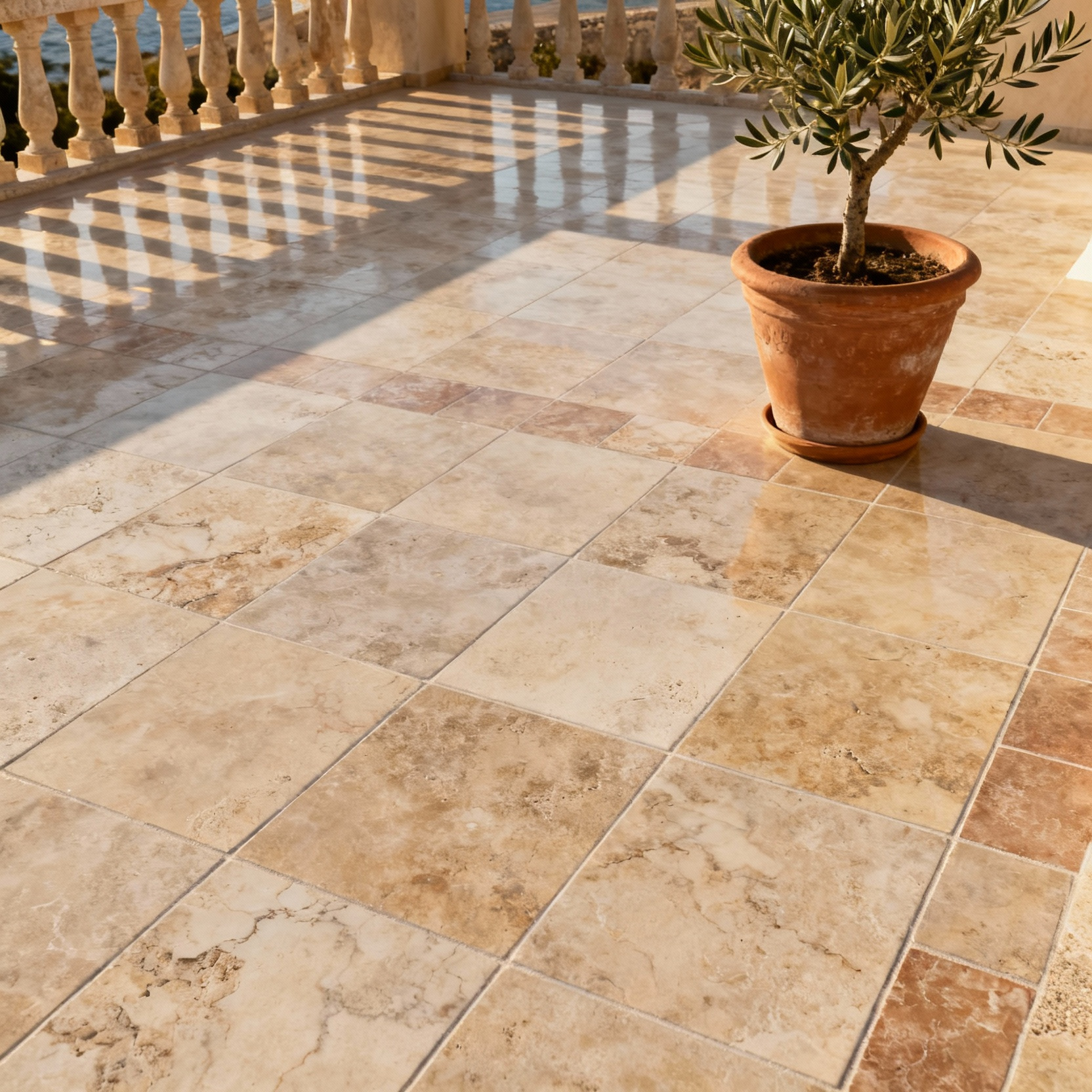
Transform your deck into a Mediterranean oasis. Diana Ramirez shares 20 masterful deck decorating ideas to create an elegant, sensory-rich outdoor haven with authentic al fresco grandeur.
The air on the Amalfi coast carries a certain magic—a mix of salty sea spray, wild jasmine, and the faint, sweet scent of lemon groves. I remember sitting on a small, sun-drenched terrace in Positano, watching a nonna carefully place a hand-painted ceramic pitcher, its surface glistening with condensation, on a rustic wooden table. She wasn’t just setting a table; she was composing a moment. After decades of immersing myself in these coastal cultures, I’ve learned that this is the secret to true Mediterranean living. It’s not about just decorating; it’s about crafting an atmosphere, a feeling, a dialogue with nature itself.
A friend recently asked me how to bring that same feeling to her own home, to transform a simple wooden deck into a vibrant extension of her life—a place for laughter, quiet mornings, and unforgettable dinners under the stars. So many people feel daunted by this, but it’s simpler than you think. The real story isn’t about buying a specific set of furniture; it’s about layering textures, scents, and personal stories.
Here are the 20 secrets I’ve gathered over the years. We’ll start by laying the foundation of the aesthetic, then we’ll layer in the rich sensory details, and finally, we’ll ensure it all harmonizes into a space that feels both timeless and deeply personal. Let’s create your own little piece of the Mediterranean, shall we?
This is our foundation. Before we add a single cushion or plant, we must get the core feeling right. It’s about building a canvas that speaks of sun, earth, and sea.
The very surface you walk on sets the entire tone. Your deck should feel as if it has been there for decades, softened by the sun and sea air. To capture this, we need to move beyond standard decking and think about materials that echo the natural landscape of the Mediterranean coast. I always guide my clients toward large-format porcelain pavers that beautifully mimic the creamy texture of travertine or the rugged charm of limestone. They offer that ancient, sun-baked feeling without the constant upkeep of real stone, a perfect blend of authenticity and modern functionality for any deck decorating project.

If you love the warmth of wood, look for composites designed to look like sun-bleached timber, aged to that lovely silvery-grey patina you see on coastal boardwalks in Greece. The goal is to choose colors that feel pulled from the earth: sandy beiges, warm terracotta tones, and soft, stony greys. From my work in Mediterranean architecture, I can tell you that this single choice is the most important you’ll make. It’s the canvas upon which every other element will be painted, so choose something with character, texture, and a soul.
Color is the emotional language of Mediterranean design. Start with a base of warm, earthy neutrals—the pure white of a Cycladic village, the creamy ochre of a Tuscan villa, the dusty green of an olive grove. These tones are calming and create a beautiful, light-filled backdrop. They make a space feel generous and open.
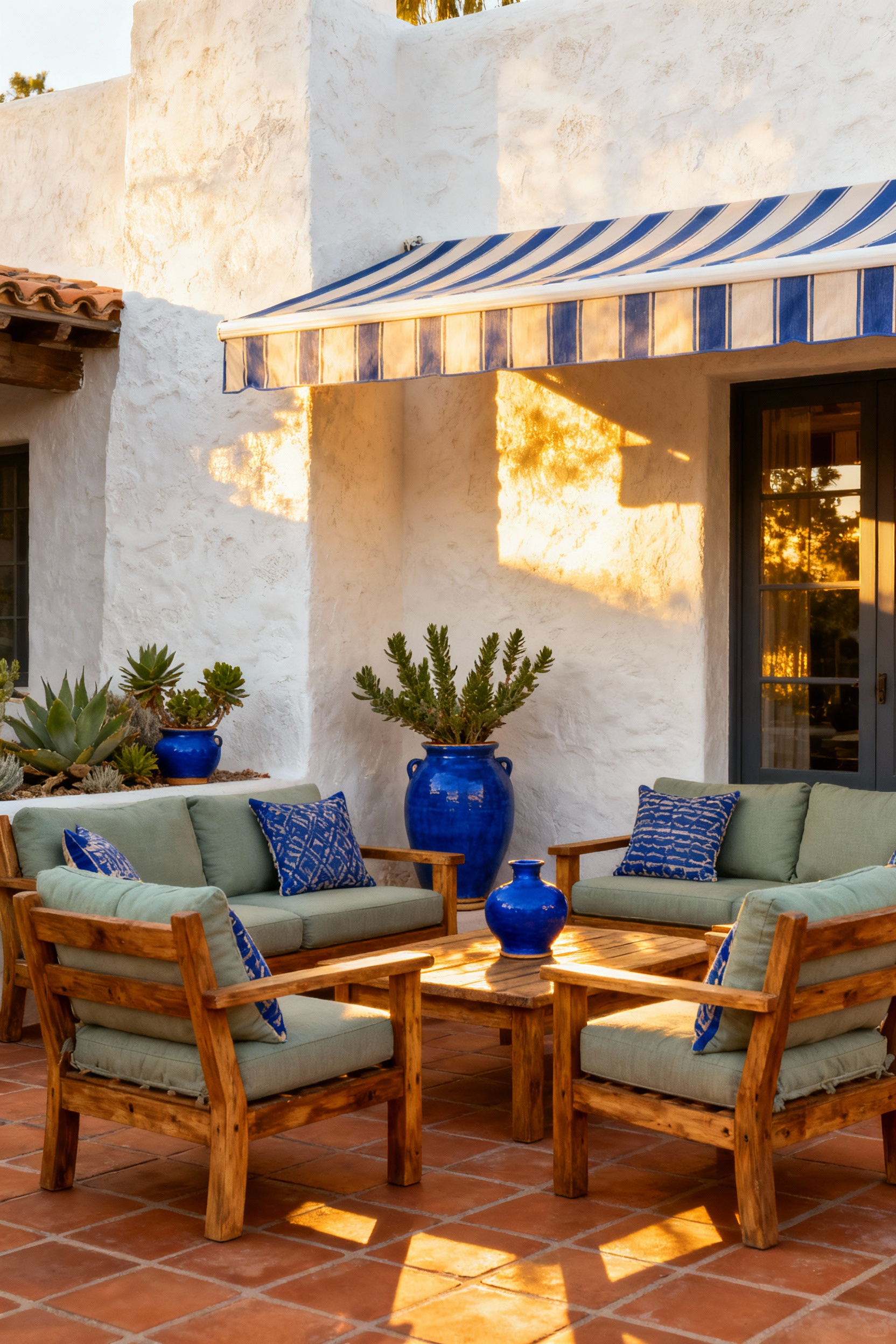
Then, for that spark of life, we bring in cobalt blue. I learned this when I saw how a single blue-painted door could electrify an entire sun-bleached alleyway in Chefchaouen. Use this vibrant blue with intention. Think of it in the pattern of a single statement cushion, in a cluster of glazed ceramic pots, or in hand-painted tiles. This contrast between the serene earth tones and the vivid blue sea is the heartbeat of the Mediterranean aesthetic, and it’s a vital part of creating a captivating deck decorating scheme.
A Mediterranean deck should feel alive, buzzing with the gentle hum of bees and fragrant with the scent of herbs. This is about more than just adding a few plants; it’s about curating a small, thriving ecosystem. Large terracotta pots are a must, overflowing with lavender whose scent perfumes the air, or with silvery-leafed olive trees that shimmer in the sunlight. I love including sprawling rosemary that releases its pungent, earthy aroma whenever you brush past it.

And you absolutely must have bougainvillea. Its explosion of fuchsia or brilliant white blossoms spilling over a railing is pure drama and romance. For my clients, I often suggest creating a small, dedicated herb garden with basil, thyme, and oregano in smaller pots near the dining area. It’s not only beautiful, but it also bridges the gap between garden and kitchen. Choosing these drought-tolerant, sun-loving plants ensures your deck is lush and vibrant without demanding constant attention, perfectly capturing the relaxed spirit of the region.
The Mediterranean lifestyle is all about connection—long meals, lingering conversations, and quiet moments of solitary repose. Your deck’s layout should invite all of these things. I advise against a single, open space. Instead, use furniture to create distinct “zones” for different activities: a cozy nook with a comfortable armchair for reading, a generous dining area for feasting with family, and a relaxed lounge for evening cocktails.

Furnish these zones with pieces that have character. Think wrought iron bistro sets, a sturdy reclaimed wood dining table, or low-slung wicker sofas with deep, comfortable linen cushions. Use larger elements like a pergola or a built-in stone bench to anchor these zones, creating a natural flow between them. It’s this thoughtful arrangement that transforms a simple deck into a multi-functional outdoor room where life can be savored. This is what truly effective deck decorating is about: creating spaces for memories to happen.
There is an undeniable romance to wrought iron. It speaks of history, craftsmanship, and an enduring elegance that feels quintessentially Mediterranean. Incorporating it into your deck design adds a layer of architectural gravitas and authentic charm that connects your space to the sun-drenched courtyards of Andalusia and the coastal villas of Italy. A simple wrought iron bistro set can create a perfect corner for morning coffee, while a beautifully crafted balustrade can turn a simple safety feature into a work of art.
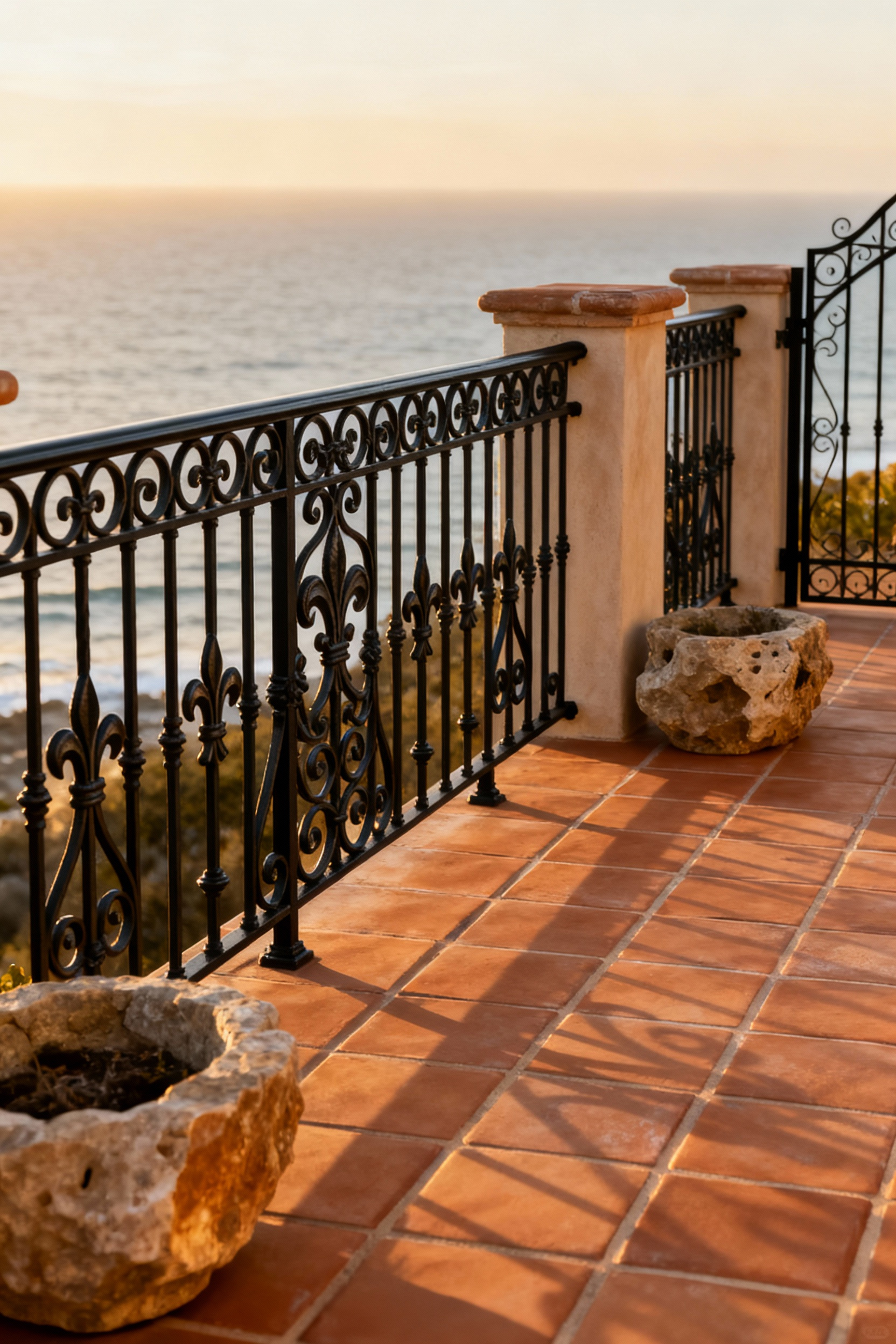
Don’t be afraid of a little rust. A natural patina on wrought iron isn’t a flaw; it’s character, a sign that the piece has lived a life outdoors. What I always tell my readers is to look for pieces with hand-hammered details and graceful curves—signs of true artistry. Pair the iron’s cool strength with soft linen cushions in creamy whites or dusty blues to create a beautiful balance of textures. It’s this interplay between hard and soft, strong and gentle, that gives a space its soul.
As the sun sets, a different kind of magic should take over your deck. Lighting is everything. Forget harsh, overhead floodlights. We want to create a soft, layered glow that feels romantic and enchanting. I always start with strings of cafe-style lights draped across a pergola or between trees. Their warm, golden light instantly creates a festive, intimate atmosphere reminiscent of a seaside piazza.
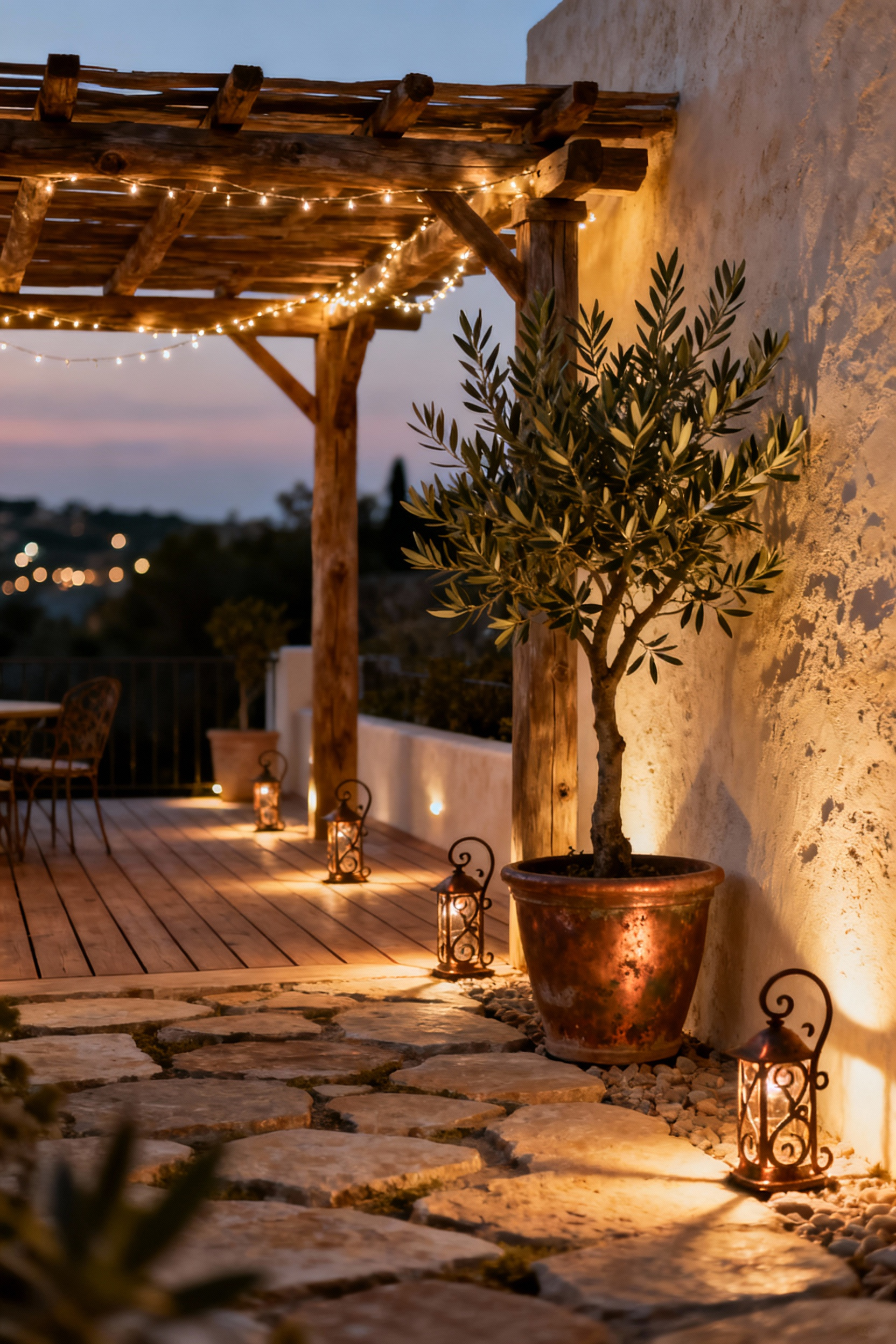
Next, add task lighting where you need it, but keep it subtle. Perhaps a stylish sconce near the door or some gentle uplighting on a beautiful olive tree. Finally, scatter candles and lanterns. Place hurricane lamps on tables or cluster lanterns on the steps. I’ve noticed that the flickering, dancing light from real flames (or very good flameless candles) makes everyone relax and lean in closer. The goal is to paint with light and shadow, creating a space that feels just as inviting after dark as it does in the bright Mediterranean sun.
Artisanal pottery is the soul of a Mediterranean garden. These aren’t just pots; they are pieces of the earth, connecting your deck to a deep tradition of craftsmanship. Terracotta is essential. Its warm, earthy color and porous nature are perfect for plants like rosemary and citrus. I love seeing a massive terracotta olive jar standing as a sculptural focal point, or a collection of smaller, aged pots grouped together.
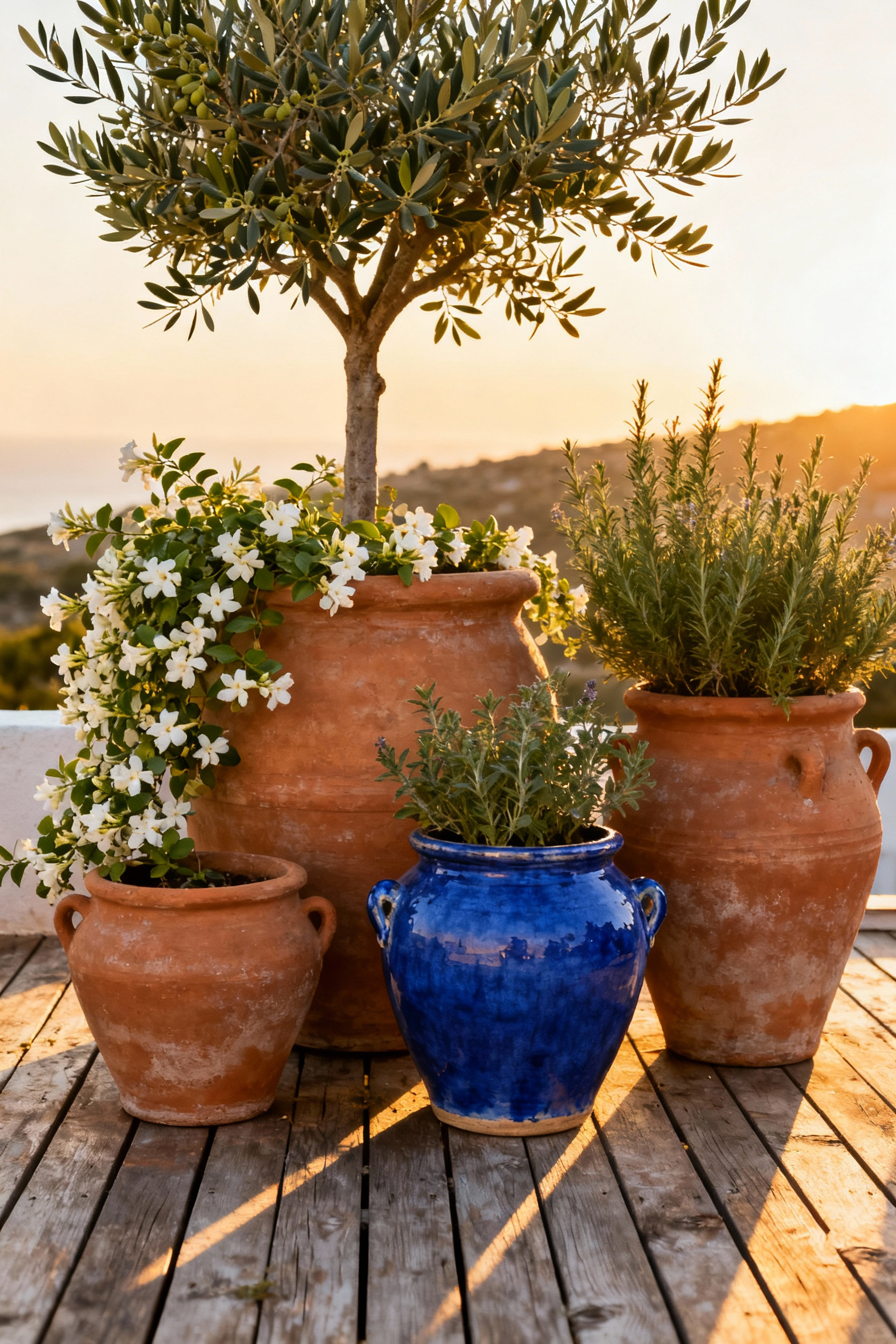
To complement the rustic terracotta, bring in the vibrant jewel tones of glazed pottery. A brilliant cobalt blue planter or an emerald green urn adds a splash of color and a touch of sophistication, much like a beautiful piece of jewelry. In my Mediterranean design expert practice, I encourage mixing these styles. Create vignettes by grouping pots of different sizes, shapes, and textures. An arrangement of a tall terracotta urn, a medium glazed pot, and a small, simple herb planter creates a dynamic and interesting composition that feels collected over time.
Now that our foundation is set, we can begin to layer in the details that engage all the senses—the touch of fabric, the scent of jasmine, the sound of water. This is where the magic really happens.
The key to comfort is texture. A truly inviting Mediterranean deck is a soft place to land. I love using natural, breathable fabrics like linen and cotton to soften the hard edges of furniture and stone. Drape billowy linen curtains from your pergola to create shady, private nooks. The way they move in the breeze adds a sense of life and romance to the space.

Layer on the comfort with an abundance of cushions and throws in our sun-drenched palette of whites, blues, and earthy neutrals. For the floor, an outdoor rug made of jute or seagrass adds a wonderful organic texture underfoot and helps to define your seating area. These textiles are not just accessories; they are essential for creating an atmosphere of relaxed, barefoot luxury. It’s about making a space that begs you to curl up with a good book and a glass of wine.
A space becomes a memory through its scent. Your deck should have its own signature fragrance, a blend of the flora we’ve planted. This is one of the most powerful and often overlooked aspects of deck decorating. Position pots of fragrant herbs like rosemary, thyme, and lavender near seating areas, so their scent is released as you walk by or as the sun warms their leaves.

For the evenings, nothing is more magical than the intoxicating perfume of night-blooming jasmine or honeysuckle. Train them up a trellis or along a railing, and as dusk falls, your entire deck will be enveloped in their sweet fragrance. The fresh, zesty scent from lemon or orange tree blossoms is another beautiful addition. I’ve seen this play out time and again: a guest will close their eyes, take a deep breath, and smile. That’s when you know you’ve created something truly special.
The history and artistry of the Mediterranean are beautifully captured in its hand-painted tiles. Using these on your deck adds a layer of bespoke character that is simply impossible to achieve with mass-produced materials. Think beyond just flooring. A wall behind an outdoor sideboard or fountain becomes a canvas for a stunning mural of intricate Andalusian or Moroccan Zellige tiles.

You can also find beautiful antique tiles at salvage yards. I once found a small batch of 19th-century Portuguese tiles that we used to create a stunning custom tabletop. Even just a few, used as accents on stair risers or inlaid into a planter box, can add so much personality. It’s the imperfections in these tiles—the slight variations in color, the handmade quality—that make them so soulful. They connect your modern home to a long and beautiful history of craftsmanship.
The sound of gently moving water is instantly calming. It masks unwanted background noise and creates a serene, meditative atmosphere. A simple water feature can completely transform the feel of your deck, making it a true oasis. It doesn’t need to be a large, elaborate fountain. A self-contained urn fountain tucked into a corner with plants, or a classic wall-mounted spout trickling into a small basin, can be incredibly effective.

I’ve found that the material makes a difference in the sound. Water falling on pebbles has a different voice than water spilling over the edge of a glazed ceramic bowl. Choose a feature whose sound you find truly relaxing. And consider lighting it from within at night for a beautiful, shimmering effect. This addition of an aural landscape is a sophisticated touch that completes the sensory experience of your outdoor sanctuary.
Shade on a Mediterranean deck isn’t just about escaping the sun; it’s an architectural feature. Instead of a standard umbrella, consider a more integrated structure. A wooden pergola, over which you can train grapevines or bougainvillea, becomes a stunning living canopy that creates beautiful, dappled light. It feels organic and deeply connected to the garden.
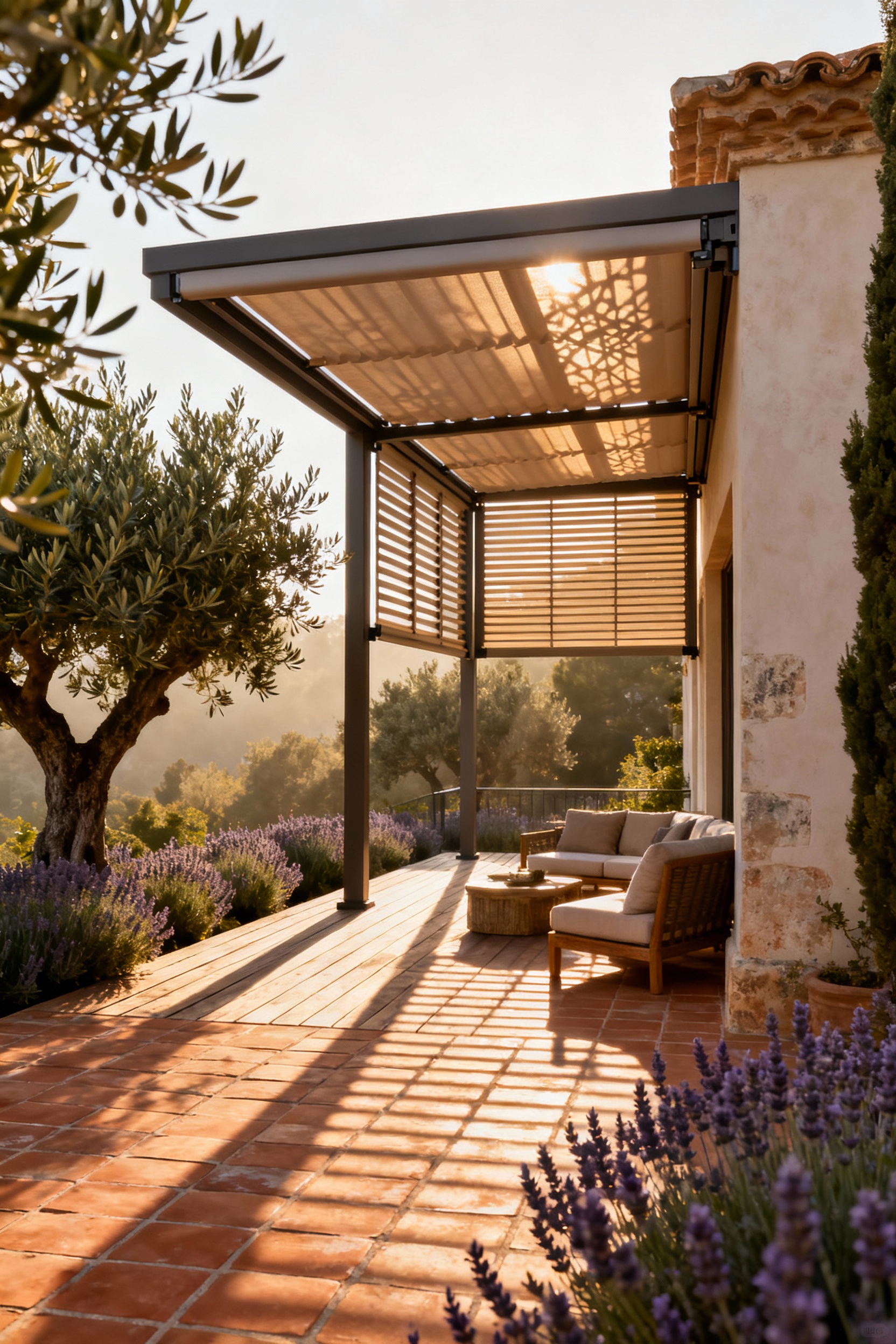
For a more modern approach with maximum flexibility, a structure with operable louvers is fantastic. You can adjust the louvers to let in the morning sun, create full shade in the heat of the afternoon, or even close them completely if a surprise shower rolls through. Whatever you choose, design it to be a beautiful object in its own right. A thoughtfully designed shade structure is a core part of your deck decorating, defining the space and making it usable and comfortable all day long.
This is a wonderful trick I learned from the tiny, walled courtyards in Seville. A large, well-placed mirror can dramatically expand the perceived size of your space. It acts like a window, reflecting the garden and the sky, creating an illusion of depth and bouncing light into shadier corners. The key is to reflect something beautiful—a lush plant, a view of the sky, or a lovely architectural detail.

Choose a mirror with a weatherproof frame, perhaps in distressed wood or aged metal, to fit the Mediterranean aesthetic. An arched mirror can even give the illusion of a doorway leading to another garden area. It’s a simple, high-impact addition that brings a touch of magic and intrigue, making a smaller deck or patio feel much more expansive and grand.
An al fresco meal is a celebration, and the table should reflect that. This is where you can truly let your personality shine. Ditch the matching dinner sets and plastic glasses. Instead, curate a collection of unique, artisanal pieces. Seek out hand-blown glassware with those beautiful, subtle imperfections that catch the light so wonderfully. Mix and match handmade ceramic plates and bowls in complementary earthy tones.
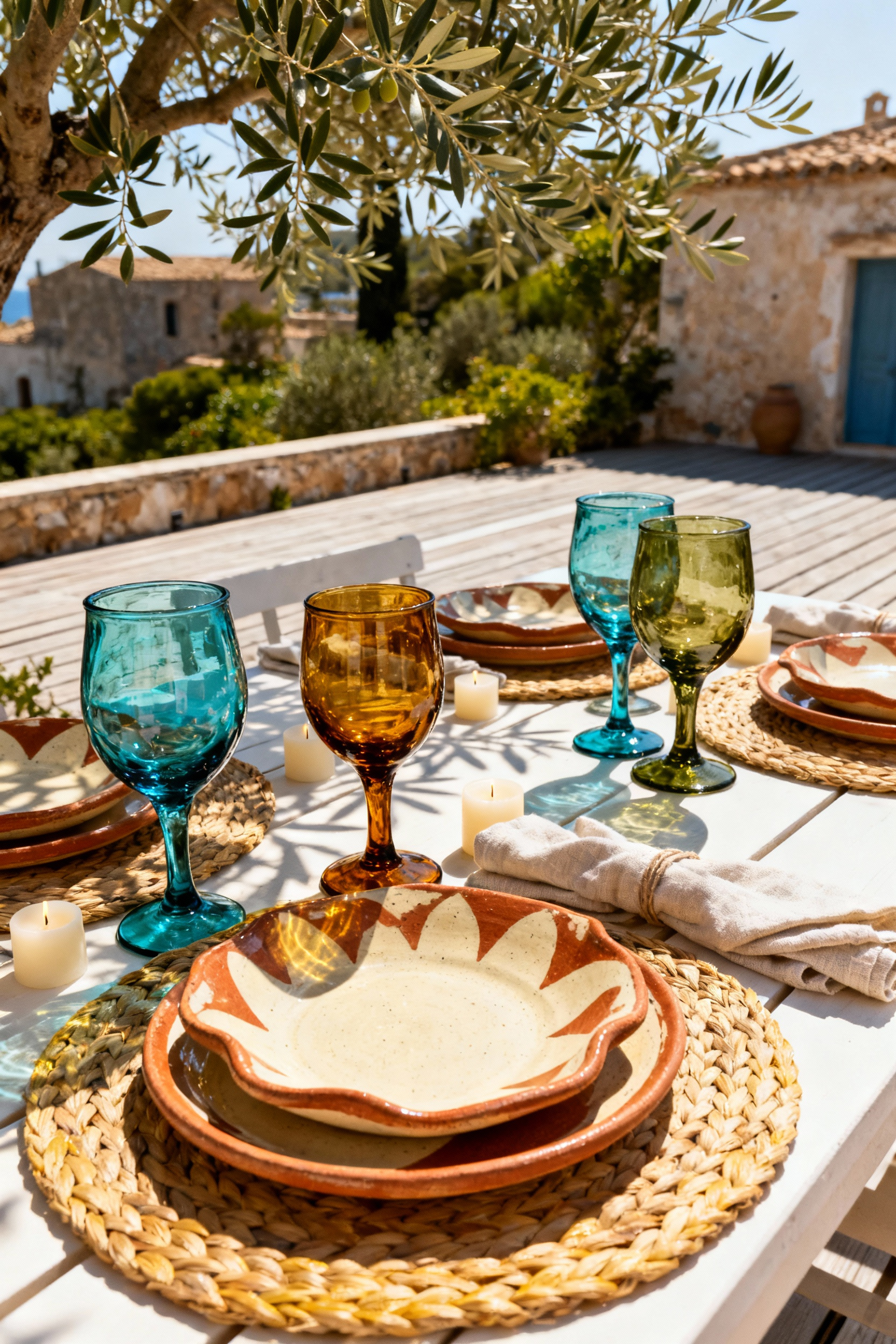
What I tell my clients is to think of their table settings as another layer of deck decorating. A beautifully glazed serving platter, a rustic linen runner, simple stoneware bowls—each piece adds to the overall story. This isn’t about formal entertaining; it’s about elevating everyday moments and honoring the simple pleasure of sharing a meal with people you love. It turns a simple dinner into a memorable event.
Finally, let’s tie everything together. These last steps are about ensuring your deck feels like a seamless, natural extension of your home, and that it ages gracefully into a space filled with character and charm.
Your deck should not feel like an afterthought. It should feel like a natural, inevitable extension of your indoor living space. The easiest way to achieve this is through continuity. Echo the color palette, textures, and style of the adjoining indoor room. If your living room has exposed wooden beams, consider a pergola of a similar wood. Use outdoor cushions and rugs that pick up on the colors of your interior decor.

The most effective way to create this flow is by using large glass doors, like bifold or sliding systems, that can open up completely to erase the boundary between inside and out. The flooring material can also be a powerful tool; using a similar-looking tile or stone both inside and out creates an unbroken visual path that draws you outdoors. When your deck decorating harmonizes with your interior, your entire living space feels larger, brighter, and more connected.
A truly successful Mediterranean deck is beautiful year-round, not just in the peak of summer. This requires a bit of planning. While your vibrant summer flowers are the stars of the show, be sure to include plants that provide interest in the cooler months. Evergreen shrubs like boxwood or pittosporum can provide structure and greenery all winter. Ornamental grasses look beautiful as they fade to gold in the autumn.

Consider plants with interesting bark or berries for winter appeal. You can also rotate seasonal potted plants. In the fall, swap out fading annuals for cyclamen or chrysanthemums in rich, autumnal shades. Years of designing coastal living spaces have taught me that this four-season approach is what creates a truly enduring garden space. Your deck will never feel barren or sad; it will simply shift its beauty with the rhythm of the year.
The beauty of Mediterranean style is that it gets better with age. The subtle patina that develops on wood, stone, and metal over time adds character and a sense of history. To achieve this, you must invest in high-quality, durable materials from the start. Choose solid teak or wrought iron for your furniture. They may cost more initially, but they will last for decades and look more beautiful with each passing year.
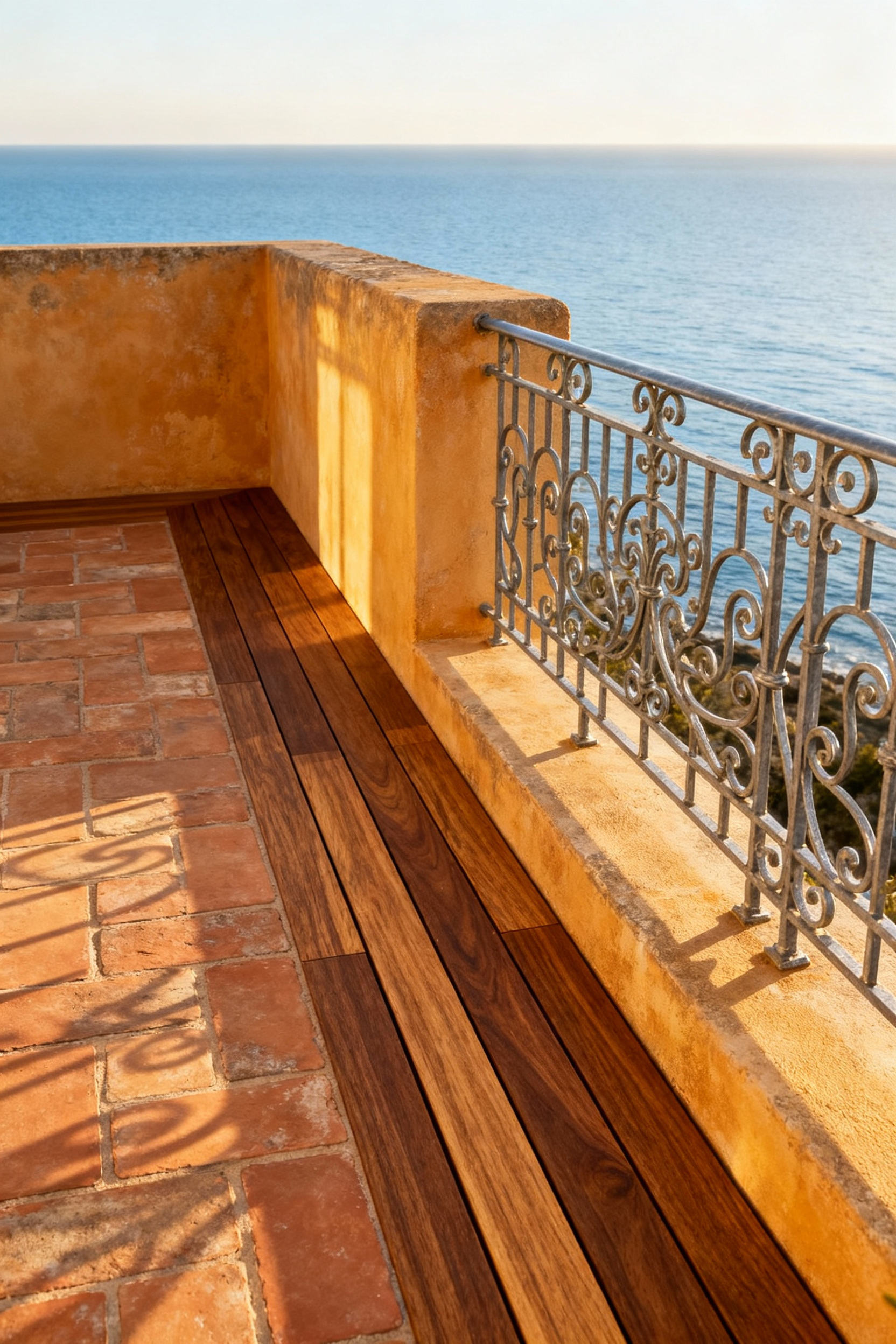
Avoid flimsy plastic and cheap finishes that will crack, fade, and look tired after just one season. For planters, choose substantial terracotta, glazed ceramic, or stone. Your deck decorating choices should be guided by a philosophy of longevity. By choosing materials that are meant to endure, you are creating a space that will mature and deepen in character alongside you and your family.
Your deck should tell your story. This is the final, most important layer of personality. Create small vignettes with objects that are meaningful to you. A collection of shells from a favorite beach trip, a small sculpture you bought on vacation, a lantern from a Moroccan souk. These aren’t just decorations; they are conversation starters and reminders of happy memories.

Group these items thoughtfully on a side table or a set of shelves. Don’t clutter the space. A few well-chosen, personal objects will have much more impact than a host of generic decor. This is what transforms a beautifully designed space into your space. It’s the final brushstroke that makes the masterpiece uniquely yours.
A great deck is never “finished.” It evolves with the seasons and with your life. I advise my clients to develop a simple seasonal rotation strategy. Have a set of lightweight, brightly colored cushions for summer, and a second set in richer, warmer tones and textures for the fall. Swap out potted annuals to reflect the changing seasons. Move furniture around to create a cozy, sheltered nook in the winter and an open, expansive layout for summer parties.
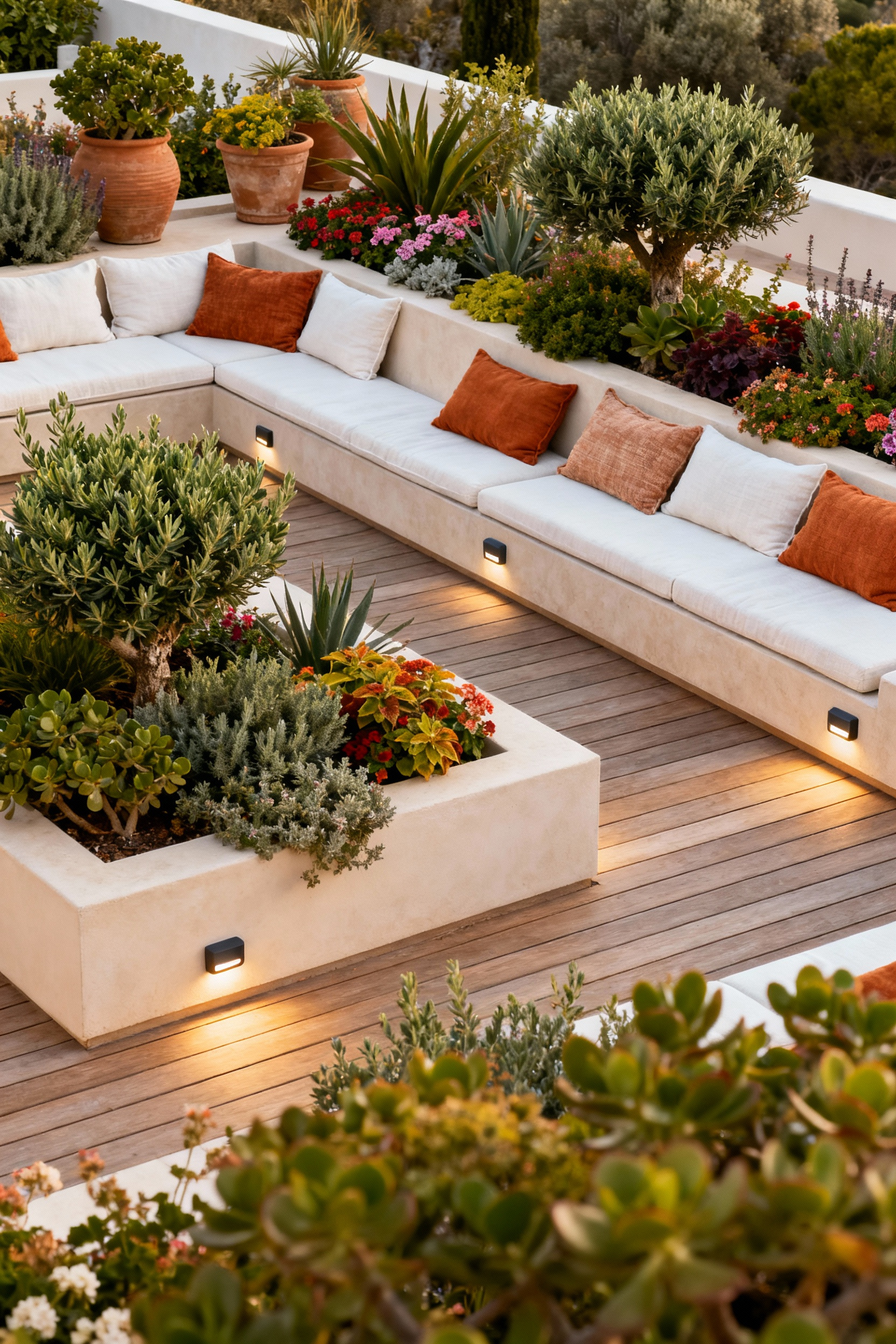
This approach keeps your deck feeling fresh and dynamic. It becomes a living part of your home, responding to the climate and your needs. Thinking about your deck decorating not as a static project but as a continual process of curation will ensure it always feels vibrant and loved.
Finally, the most important secret of all: let it be a little imperfect. Mediterranean style is not about sharp, sterile perfection. It’s about the beauty of real life. A slightly chipped terracotta pot, the faded patina on a wooden table, a cushion that’s softened with use—these are not flaws. They are signs of a space that is lived in and loved.

Don’t be afraid to let things age naturally. A little wear and tear tells a story. What really gets me is when a space feels too perfect, too staged. Relax, enjoy your beautiful deck, spill a little wine, and let it become a rich tapestry woven with the memories of a life well-lived. That is the true heart of al fresco grandeur.
And there you have it. We’ve journeyed from the foundational earth beneath our feet to the soft glow of evening candlelight, touching on every sense along the way. My hope is that you now see your deck not just as an outdoor space, but as a canvas for creating a lifestyle—one that values beauty, connection, and the simple joy of being outdoors. These 20 principles are more than a checklist; they are an invitation to slow down, to observe, and to create with intention.
This process of deck decorating is about curating moments. It’s about designing a backdrop for lazy Sunday mornings with a newspaper, for boisterous family dinners that last long after the sun has set, and for quiet evenings spent gazing at the stars. So take these ideas, infuse them with your own stories and passions, and begin the beautiful work of crafting your own personal Mediterranean escape. May it be a place where life’s most cherished moments unfold, season after beautiful season.